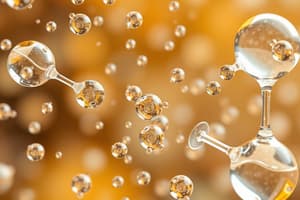Podcast
Questions and Answers
The state of matter characterized by a definite volume but no definite shape is a ______.
The state of matter characterized by a definite volume but no definite shape is a ______.
liquid
Table salt, or sodium chloride (NaCl), is an example of a ______ because it consists of sodium and chlorine chemically bonded together.
Table salt, or sodium chloride (NaCl), is an example of a ______ because it consists of sodium and chlorine chemically bonded together.
compound
A salad is classified as a ______ mixture because its components are not uniformly distributed and are easily observed.
A salad is classified as a ______ mixture because its components are not uniformly distributed and are easily observed.
heterogeneous
The ______ is the smallest unit of an element that retains the chemical properties of that element.
The ______ is the smallest unit of an element that retains the chemical properties of that element.
The number of ______ in the nucleus of an atom determines its atomic number and defines the element.
The number of ______ in the nucleus of an atom determines its atomic number and defines the element.
Elements in the same vertical column of the periodic table, also known as a ______, share similar chemical properties due to their identical valence electron configurations.
Elements in the same vertical column of the periodic table, also known as a ______, share similar chemical properties due to their identical valence electron configurations.
[Blank] bonds involve the sharing of electrons between atoms, forming molecules with specific shapes and properties.
[Blank] bonds involve the sharing of electrons between atoms, forming molecules with specific shapes and properties.
In ______ bonds, electrons are delocalized and shared among many atoms, resulting in high electrical and thermal conductivity.
In ______ bonds, electrons are delocalized and shared among many atoms, resulting in high electrical and thermal conductivity.
In a chemical reaction, the starting materials are known as ______.
In a chemical reaction, the starting materials are known as ______.
The quantitative study of chemical reactions, which involves using mole ratios to calculate amounts of reactants and products, is known as ______.
The quantitative study of chemical reactions, which involves using mole ratios to calculate amounts of reactants and products, is known as ______.
Substances that donate protons or accept electrons are classified as ______.
Substances that donate protons or accept electrons are classified as ______.
The branch of chemistry that studies carbon-containing compounds is known as ______.
The branch of chemistry that studies carbon-containing compounds is known as ______.
The transition of matter from a solid to a liquid state is called ______.
The transition of matter from a solid to a liquid state is called ______.
Reactions that release heat into the surroundings are described as ______ reactions, characterized by a negative enthalpy change.
Reactions that release heat into the surroundings are described as ______ reactions, characterized by a negative enthalpy change.
The study of reaction rates and reaction mechanisms is known as ______.
The study of reaction rates and reaction mechanisms is known as ______.
The principle that states that if a change of condition is applied to a system in equilibrium, the system will shift in a direction that relieves the stress is known as ______'s principle.
The principle that states that if a change of condition is applied to a system in equilibrium, the system will shift in a direction that relieves the stress is known as ______'s principle.
A homogeneous mixture of a solute and a solvent is called a ______.
A homogeneous mixture of a solute and a solvent is called a ______.
Reactions that involve the transfer of electrons between chemical species are known as ______ reactions.
Reactions that involve the transfer of electrons between chemical species are known as ______ reactions.
Flashcards
Chemistry
Chemistry
The study of matter, its properties, and how it changes.
Matter
Matter
Anything that has mass and takes up space.
Element
Element
Pure substance with only one type of atom that cannot be broken down chemically.
Compound
Compound
Signup and view all the flashcards
Mixture
Mixture
Signup and view all the flashcards
Atom
Atom
Signup and view all the flashcards
Periodic Table
Periodic Table
Signup and view all the flashcards
Chemical Bonds
Chemical Bonds
Signup and view all the flashcards
Reactants
Reactants
Signup and view all the flashcards
Products
Products
Signup and view all the flashcards
Stoichiometry
Stoichiometry
Signup and view all the flashcards
Acids
Acids
Signup and view all the flashcards
Bases
Bases
Signup and view all the flashcards
Organic Chemistry
Organic Chemistry
Signup and view all the flashcards
Boiling/Vaporization
Boiling/Vaporization
Signup and view all the flashcards
Exothermic Reactions
Exothermic Reactions
Signup and view all the flashcards
Reaction Rate
Reaction Rate
Signup and view all the flashcards
Solution
Solution
Signup and view all the flashcards
Study Notes
The provided text is the same as the existing notes, therefore no changes have been made.
Studying That Suits You
Use AI to generate personalized quizzes and flashcards to suit your learning preferences.
Description
Explore chemistry with an overview of matter, its different states (solid, liquid, gas, plasma), and the classification of matter into elements, compounds, and mixtures. Understand the basic building blocks of chemistry.




